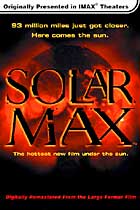
SOLAR MAX
Julie Crawford
Reel Life
Directed by John Weiley.
ACTION! Suspense! Science!
Science? The word sends many of us running in the opposite direction,
Newton's Laws of Motion having haunted us since high school physics class.
But Solarmax, the newest film to hit the Omnimax screen, is sure to keep
even the most science-fearing viewer riveted to his seat.
Solar max is the name for the phenomenon that occurs every 11 years when
the sun's poles reverse, resulting in a period of violent solar activity.
How fitting that at the turn of the century we should be smack in the
middle of a solar max, which can interrupt satellite communication and
wreak havoc with computers and telephone service.
Director John Weiley takes us on a historical and scientific journey.
The first and most impressive aspect of Weiley's film is the disclaimer
at the beginning, which states that no computer-generated images were
used in the making of the film.
And the images are amazing. NASA and the European Space Agency (ESA) worked
closely with the film crew, which resulted in rare and breathtaking footage,
which all but jumps off of the Omnimax's 27-metre-wide screen.
The journey starts in Ireland with the earliest structure containing proof
of scientific thought (2300 BC). "The cave of the sun," which
still stands today, is built so that on the Winter Solstice, the sun's
rays are funnelled precisely down a series of corridors to illuminate
an inner chamber. The ancient city of Machu Picchu in Peru contains a
similar structure.
The film takes us to other locations in Bolivia, Japan, Norway, the Caribbean
and Australia, chronicling the different ways we celebrate and what we
believe about the Sun, the Earth's nearest star.
The Sun is praised for giving us the energy we need to survive, but the
solar max phenomenon is blamed for everything from modern-day cell phone
disruptions to the eradication of the Norse settlement of Qaqortoq, Greenland.
Ruins there point to a land that was several degrees warmer when it was
settled, only to return to its inhabitable temperature once the solar
max period was over. All the settlers perished.
You don't have to be a nuclear physicist to enjoy Solarmax. The barrage
of scientific information is presented in an entirely accessible manner,
set against beautiful scenery, with starting solar images and energized
world-beat music enhancing the journey.
An excellent film chronicling humankind's relationship with the Sun, from
the beginning of time through to that inevitable dark day, when the Sun
will swell and swallow the Earth.
review source: www.nsnews.com